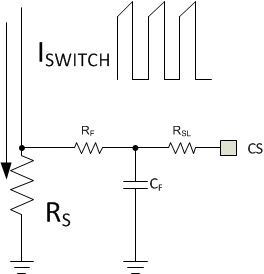SNVA941A June 2020 – November 2022 LM5156 , LM5156-Q1 , LM51561 , LM51561-Q1 , LM51561H , LM51561H-Q1 , LM5156H , LM5156H-Q1
- How to Design a Boost Converter Using the LM5156
- 1LM5156 Design Example
- 2Example Application
-
3Calculations and Component Selection
- 3.1 Switching Frequency
- 3.2 Inductor Calculation
- 3.3 Current Sense Resistor Calculation
- 3.4 Inductor Selection
- 3.5 Diode Selection
- 3.6 MOSFET Selection
- 3.7 Output Capacitor Selection
- 3.8 Input Capacitor Selection
- 3.9 UVLO Resistor Selection
- 3.10 Soft-Start Capacitor Selection.
- 3.11 Feedback Resistor Selection
- 3.12 Control Loop Compensation
- 3.13 Efficiency Estimation
- 4Component Selection Summary
- 5Small-Signal Frequency Analysis
- 6Revision History
3.3 Current Sense Resistor Calculation
Selecting the switch current sense network components is described in the following section. Figure 3-1 shows the four components that make up the current sense network of the LM5156. RS is the current sense resistor. This resistor senses the switch current, and also sets the peak current limit of the inductor current. RF and CF form a low pass filter. This filter helps minimize high frequency noise on the current sense signal caused by the MOSFET turning on. RSL sets the external slope compensation and is optional. In some applications where the internal slope compensation is not large enough RSL will be required.
 Figure 3-1 LM5156 Current Sense Network
Figure 3-1 LM5156 Current Sense Network